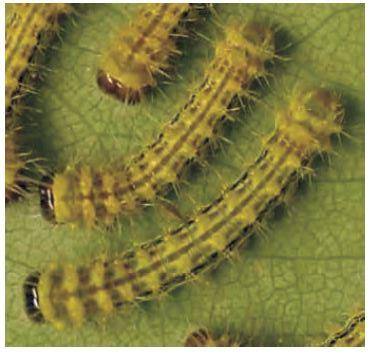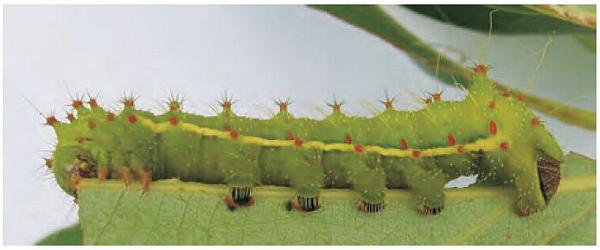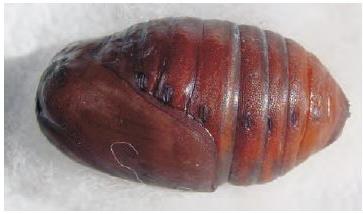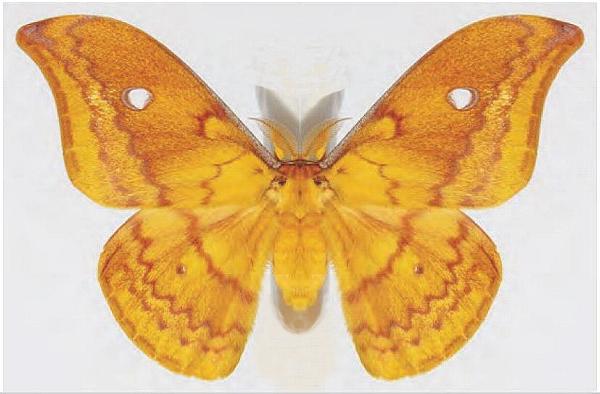
Photo: courtesy of David A. Lane, (Ted) E.D. Edwards, & Stefan Naumann, from
A revision of the genus Syntherata Maasen, 1873 (Lepidoptera: Saturniidae) within Australia,
with the description of three new species, and descriptions of their life histories,
The European Entomologist, Volume 3, Part 1 (2010), pp. 21-27
The young caterpillars of this species are yellow with a dark line along the back,
and a black line along each side, have a black head, and are covered in stiff hairs.

Photo: courtesy of David A. Lane, (Ted) E.D. Edwards, & Stefan Naumann, from
A revision of the genus Syntherata Maasen, 1873 (Lepidoptera: Saturniidae) within Australia,
with the description of three new species, and descriptions of their life histories,
The European Entomologist, Volume 3, Part 1 (2010), pp. 21-27
Later the caterpillars become olive green with a yellow line
along each side, and have pink-tipped tubercles
each of which has a cluster of short stiff hairs.
The caterpillars have been found feeding on the leaves of various trees
from RHIZOPHORACEAE
including :
Spurred Mangrove ( Ceriops tagal ), and
Spotted Mangrove ( Rhizophora stylosa ).

pupa, taken out of its cocoon
Photo: courtesy of David A. Lane, (Ted) E.D. Edwards, & Stefan Naumann, from
A revision of the genus Syntherata Maasen, 1873 (Lepidoptera: Saturniidae) within Australia,
with the description of three new species, and descriptions of their life histories,
The European Entomologist, Volume 3, Part 1 (2010), pp. 21-27
The caterpillar pupates in an oval cocoon on the food plant
or nearby vegetation.

Photo: courtesy of David A. Lane, (Ted) E.D. Edwards, & Stefan Naumann, from
A revision of the genus Syntherata Maasen, 1873 (Lepidoptera: Saturniidae) within Australia,
with the description of three new species, and descriptions of their life histories,
The European Entomologist, Volume 3, Part 1 (2010), pp. 21-27
There is a considerable variation in the coloration of
adults of this species.
The basic adult moth is yellow with
two or more zig-zag brown or pink lines across each wing.
The forewings each have a round transparent spot in the middle,
and the hindwings each have a dark spot in the middle.
There is also wine-red variety.
The male has recurved wingtips to the forewings,
whereas the females have rounded forewing tips.
The moth typically has a wingspan of 10 cms.
The species occurs in
Queensland.

eggs, highly magnified
Photo: courtesy of David A. Lane, (Ted) E.D. Edwards, & Stefan Naumann, from
A revision of the genus Syntherata Maasen, 1873 (Lepidoptera: Saturniidae) within Australia,
with the description of three new species, and descriptions of their life histories,
The European Entomologist, Volume 3, Part 1 (2010), pp. 21-27
The eggs are laid in short rows,
and are pale green and ovate, and have a diameter of about 1.5 mm.
The species is heavily parasitised by wasps and flies.
Further reading:
David Lane,
A new species of Syntherata Maasen (Lepidoptera: Saturniidae) from northern Australia,
Butterfly & Other Invertebrates Club Inc. Newsletter,
Number 31 (2003), pp. 6-12.
David A. Lane, (Ted) E.D. Edwards, & Stefan Naumann,
A revision of the genus Syntherata Maasen, 1873 (Lepidoptera: Saturniidae) within Australia,
with the description of three new species, and descriptions of their life histories,
The European Entomologist,
Volume 3, Part 1 (2010), pp. 21-27, figs. 6, 19, 54-69.
(updated 1 July 2007, 4 December 2017, 29 December 2020)










